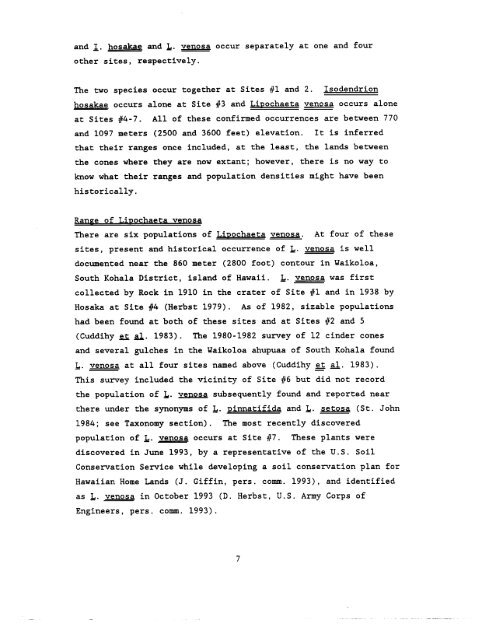RECOVERY PLAN FOR - U.S. Fish and Wildlife Service
RECOVERY PLAN FOR - U.S. Fish and Wildlife Service
RECOVERY PLAN FOR - U.S. Fish and Wildlife Service
You also want an ePaper? Increase the reach of your titles
YUMPU automatically turns print PDFs into web optimized ePapers that Google loves.
<strong>and</strong> I. hosakae <strong>and</strong> ~. venosa occur separately at one <strong>and</strong> four<br />
other sites, respectively.<br />
The two species occur together at Sites #1 <strong>and</strong> 2. Isodendrion<br />
hosakae occurs alone at Site #3 <strong>and</strong> Livochaeta venosa occurs alone<br />
at Sites #4-7. All of these confirmed occurrences are between 770<br />
<strong>and</strong> 1097 meters (2500 <strong>and</strong> 3600 feet) elevation. It is inferred<br />
that their ranges once included, at the least, the l<strong>and</strong>s between<br />
the cones where they are now extant; however, there is no way to<br />
know what their ranges <strong>and</strong> population densities might have been<br />
historically.<br />
Range of Lioochaeta venosa<br />
There are six populations of Litochaeta venosa. At four of these<br />
sites, present <strong>and</strong> historical occurrence of L. venosa is well<br />
documented near the 860 meter (2800 foot) contour in Waikoloa,<br />
South Kohala District, isl<strong>and</strong> of Hawaii. L. venosa was first<br />
collected by Rock in 1910 in the crater of Site #1 <strong>and</strong> in 1938 by<br />
Hosaka at Site #4 (Herbst 1979). As of 1982, sizable populations<br />
had been found at both of these sites <strong>and</strong> at Sites #2 <strong>and</strong> 5<br />
(Cuddihy ~ j~. 1983). The 1980-1982 survey of 12 cinder cones<br />
<strong>and</strong> several gulches in the Waikoloa ahupuaa of South Kohala found<br />
L. venosa at all four sites named above (Cuddihy et ~j. 1983).<br />
This survey included the vicinity of Site #6 but did not record<br />
the population of ~. y~~j subsequently found <strong>and</strong> reported near<br />
there under the synonyms of L. ~innatifida<strong>and</strong> J~. setosa (St. John<br />
1984; see Taxonomy section). The most recently discovered<br />
population of j~. venosa occurs at Site #7. These plants were<br />
discovered in June 1993, by a representative of the U.S. Soil<br />
Conservation <strong>Service</strong> while developing a soil conservation plan for<br />
Hawaiian Home L<strong>and</strong>s (J. Giffin, pers. comm. 1993), <strong>and</strong> identified<br />
as L. venosa in October 1993 (D. Herbst, U.S. Army Corps of<br />
Engineers, pers. comm. 1993).<br />
7

















